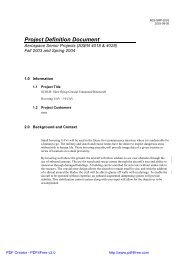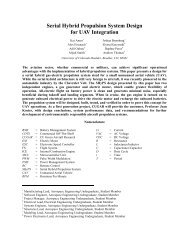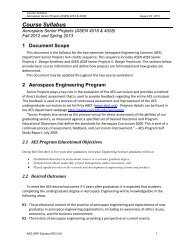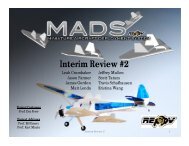PFR - Aerospace Engineering Sciences Senior Design Projects ...
PFR - Aerospace Engineering Sciences Senior Design Projects ...
PFR - Aerospace Engineering Sciences Senior Design Projects ...
Create successful ePaper yourself
Turn your PDF publications into a flip-book with our unique Google optimized e-Paper software.
Project Final Report – CUDBF April 30 th , 2009<br />
ASEN 4028: <strong>Aerospace</strong> <strong>Senior</strong> <strong>Projects</strong><br />
clearance is available with the wing-tips folded: This was determined using the code provided in<br />
Appendix D<br />
Figure 32: Assembly Feasibility<br />
The wing area was determined to be 7.14 ft 2 from the performance sizing. Using an upper bound<br />
of 25° leading edge wing sweep, and a nominal taper ratio of 0.5, the leading edge of the wing at<br />
the fold is 19 in behind the nose. This means the aircraft will be 23 in long when folded in the<br />
box. This was the upper bound because ½ in thickness for the walls of the box was assumed. It is<br />
also important to note that even with a 14 in propeller (the largest under consideration for the<br />
project), the propellers can still be mounted on the front of the aircraft with adequate clearance<br />
from the wing, and still remain behind the nose of the aircraft. Based upon this information, it is<br />
entirely feasible to fit the flying wing inside a 2’ x 2’ x 4’ box by only folding the wingtips.<br />
7.2 Risk Assessment<br />
The largest risks involved with designing the Buff-2 Bomber are enough to warrant concern and<br />
additional analysis in order to alleviate as much danger of total aircraft failure. The major risks<br />
from each subsystem were further analyzed to determine the overall importance, probability, and<br />
mitigation.<br />
7.2.1 Aerodynamics<br />
Insufficient stability of the aircraft would result in a loss of pilot control and erratic flight.<br />
Included in this risk is the possibility of aircraft damage during takeoff and landing if the<br />
unstable nature of the aircraft prompts the plane to pitch or roll when operating at low velocities.<br />
Should the aircraft be unstable, the control surfaces would be unable to compensate and a crash<br />
is imminent. This was mitigated through extensive analysis and research into airfoils and design<br />
of flying wings. Even with the amount of time devoted to aerodynamic design, the probability of<br />
instabilities is still at a medium level. However, because the consequences are so great, that this<br />
aerodynamic risk possibilities are still undergoing continuous analysis.<br />
57
















